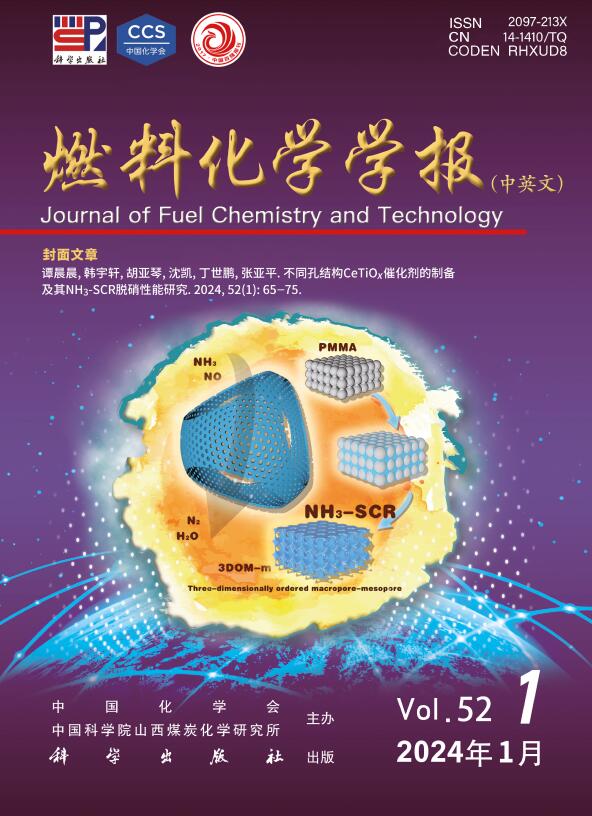CO与不同晶格氧在Cu掺杂CeO2(111)上的反应性:DFT研究
Q3 Energy
引用次数: 0
摘要
采用DFT方法研究了Cu掺杂CeO2(111)在不同点阵氧位上对CO的吸附,并分析了吸附体系的几何结构和电子性质。结果表明,CO与第一层晶格氧相互作用形成CO2。而在第二层晶格氧上吸附时,第一层晶格氧参与形成碳酸盐种,即CO在第一层和第二层晶格氧上共吸附。对于第二层吸附,CO的绝对吸附能在Cu附近的os上较大。这类碳酸盐具有较好的热力学稳定性,主要归因于Cu对CO的促进作用,表现为从c2p轨道向Cu 3d轨道的电子迁移行为。而在远离Cu的os上,CO的绝对吸附能很小。与碳酸盐的形成相比,地层CO2的绝对吸附能非常小,说明第二层形成的碳酸盐是稳定的。此外,当CO在有碳酸盐的体系上吸附时,CO的绝对吸附能明显小于未碳化体系,这表明碳酸盐的形成抑制了CO在Cu/CeO2上的氧化(111)。因此,碳酸盐的形成不利于Cu/CeO2的CO氧化反应(111)。本研究结果为CO2对铈基催化剂的负面影响提供了理论支持。本文章由计算机程序翻译,如有差异,请以英文原文为准。
The reactivity of CO with different lattice oxygens on Cu doped CeO2(111): A DFT study
The adsorption of CO on different lattice oxygen sites in Cu doped CeO2(111) was studied by DFT method, and the geometrical structure and electronic properties of adsorption systems were analyzed. The results showed that CO interacted with lattice oxygen on the first layer formed CO2. However, when adsorbed on the second layer lattice oxygen, carbonate species were formed with the participation of first layer lattice oxygens, i.e., CO co-adsorbed on first and second layer lattice oxygens. For the second layer adsorption, the absolute CO adsorption energy was big on the Oss nearby Cu. This kind of carbonates was thermodynamically stable, and it was attributed to the facilitation of Cu on CO adsorption, manifested by an electron migration behavior from the C 2p orbitals to the Cu 3d orbitals. However, the absolute CO adsorption energy on the Oss away from Cu was small. Compared to the formation of carbonates, the formation CO2 had very small absolute adsorption energy, suggesting the formed carbonates on second layer was stable. Further, when CO adsorbed on the systems with a carbonate, the absolute CO adsorption energy was significantly smaller than that of the non-carbonated system, indicating that the formation of carbonates inhibited CO oxidation on Cu/CeO2(111). Therefore, the formation of carbonates was unfavorable for CO oxidation reaction on Cu/CeO2(111). The results of this study provide theoretical support for the negative effect of CO2 on ceria-based catalysts.
求助全文
通过发布文献求助,成功后即可免费获取论文全文。
去求助
来源期刊

燃料化学学报
Chemical Engineering-Chemical Engineering (all)
CiteScore
2.80
自引率
0.00%
发文量
5825
期刊介绍:
Journal of Fuel Chemistry and Technology (Ranliao Huaxue Xuebao) is a Chinese Academy of Sciences(CAS) journal started in 1956, sponsored by the Chinese Chemical Society and the Institute of Coal Chemistry, Chinese Academy of Sciences(CAS). The journal is published bimonthly by Science Press in China and widely distributed in about 20 countries. Journal of Fuel Chemistry and Technology publishes reports of both basic and applied research in the chemistry and chemical engineering of many energy sources, including that involved in the nature, processing and utilization of coal, petroleum, oil shale, natural gas, biomass and synfuels, as well as related subjects of increasing interest such as C1 chemistry, pollutions control and new catalytic materials. Types of publications include original research articles, short communications, research notes and reviews. Both domestic and international contributors are welcome. Manuscripts written in Chinese or English will be accepted. Additional English titles, abstracts and key words should be included in Chinese manuscripts. All manuscripts are subject to critical review by the editorial committee, which is composed of about 10 foreign and 50 Chinese experts in fuel science. Journal of Fuel Chemistry and Technology has been a source of primary research work in fuel chemistry as a Chinese core scientific periodical.
 求助内容:
求助内容: 应助结果提醒方式:
应助结果提醒方式:


